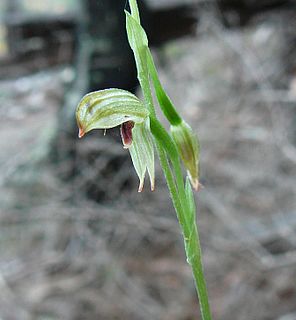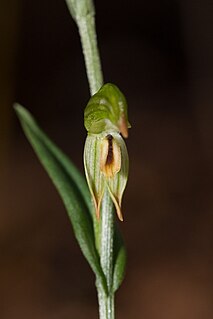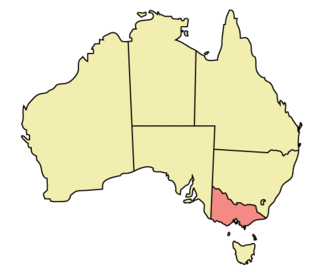
Pterostylis chlorogramma, commonly known as the green-striped leafy greenhood, is a plant in the orchid family Orchidaceae and is endemic to Victoria. Flowering plants have up to seven translucent green flowers with darker green stripes. The flowers have a green labellum with a darker stripe down the middle. Non-flowering plants have a rosette of leaves on a short, thin stalk but flowering plants lack the rosette, instead having five to seven stem leaves.

Pterostylis crassicaulis, commonly known as the alpine swan greenhood, is a plant in the orchid family Orchidaceae and is endemic to south-eastern Australia. It has a rosette of leaves and up to 18 bluish-green and white flowers with dark green stripes. The flowers have a labellum with a dark green, beak-like appendage. It is similar to P. cycnocephala but is more robust and grows at higher altitudes.

Pterostylis tunstallii, commonly known as Tunstall's greenhood or granite greenhood is a plant in the orchid family Orchidaceae and is endemic to south-eastern Australia. Flowering plants have up to ten transparent green flowers which have a dark brown, insect-like labellum with a blackish "head". Non-flowering plants have a rosette of leaves on a short stalk but flowering plants lack the rosette, instead having five to eight stem leaves.

Pterostylis jonesii, commonly known as the montane leafy greenhood, is a plant in the orchid family Orchidaceae and is endemic to a small area of south-eastern Australia. Individual plants have either a rosette of three to six leaves or a flowering spike with up to eleven flowers and five to seven stem leaves. The flowers are translucent green with faint darker green lines and have a brownish-yellow labellum with a dark stripe.

Pterostylis multiflora, commonly known as the tall tiny greenhood, is a species of orchid endemic to south-eastern Australia. As with similar orchids, plants in flower differ from those that are not. Those not in flower have a rosette of leaves lying flat on the ground. Plants in flower lack a rosette but have up to twenty tiny green, white, and brown flowers in summer. The flowering stem has up to six stem leaves.
Pterostylis agrestis is a plant in the orchid family Orchidaceae and is endemic to Victoria. It has a rosette of leaves and when flowering, up to fourteen transparent green flowers with a blunt, greenish-black appendage on the labellum. It is similar to the black-tip greenhood, Pterostylis bicolor but that species has larger, less crowded flowers and is found in different habitats.
Pterostylis clivicola is a plant in the orchid family Orchidaceae and is endemic to a small area near the border between New South Wales and Victoria. It has a rosette of leaves and up to fourteen green flowers which have a labellum with a dark green, beak-like appendage.

Pterostylis daintreana, commonly known as Daintree's greenhood, is a species of orchid endemic to eastern Australia. The non-flowering plants have a rosette of leaves on short stalks but flowering plants have up to ten flowers with rosettes on the side of the flowering spike. The flowers are translucent white with dark green lines and long, downcurved lateral sepals.

Pterostylis depauperata, commonly known as the keeled greenhood, is a species of orchid endemic to Queensland. Flowering plants have a rosette of leaves at the base of a flowering stem with a single small white flower with pale green marks, and a few small stem leaves. Non-flowering plants only have a rosette of leaves. All three sepals on the flower have relatively long, thread-like tips.
Pterostylis incognita, commonly known as the Sale greenhood, is a plant in the orchid family Orchidaceae and is endemic to Victoria. It has a rosette of leaves and when flowering, up to twelve crowded flowers on a stem with a rosette at the base. The type specimen was collected near Sale in 1895 but was not formally described or given a name until 2009, by which time it was presumed extinct.
Pterostylis loganii, commonly known as the Logan's leafy greenhood, is a plant in the orchid family Orchidaceae and is endemic to a small area near the border between New South Wales and Victoria. Flowering plants have up to five pale green flowers with darker green stripes and brownish tips. The flowers have a brown labellum with a blackish stripe and a blackish mound near its base. Non-flowering plants have a rosette of leaves on a short, thin stalk but flowering plants lack the rosette, instead having five to seven stem leaves.
Pterostylis macrosepala is a plant in the orchid family Orchidaceae and is endemic to New South Wales where it grows on the central-west slopes. As with similar greenhoods, the flowering plants differ from those which are not flowering. The non-flowering plants have a rosette of leaves flat on the ground but the flowering plants have up to eight translucent green flowers with narrow, dark green stripes and up to ten stem leaves.

Pterostylis prasina, commonly known as the mallee leafy greenhood, is a plant in the orchid family Orchidaceae and is endemic to southern continental Australia. Non-flowering have a rosette of leaves on a short stalk, but flowering plants lack the rosette and have up to eight pale green and translucent green flowers with darker green lines. The flowers have a pale green labellum with a darker central line. It is a common and widespread greenhood in parts of Victoria and South Australia.
Pterostylis pratensis, commonly known as the Liawenee greenhood, is a plant in the orchid family Orchidaceae and is endemic to Tasmania. Both flowering and non-flowering plants have a rosette of leaves lying flat on the ground. Flowering plants have up to twelve crowded white flowers with prominent green stripes. This greenhood only grows in low, exposed subalpine tussock grassland.
Pterostylis rubenachii, commonly known as the Arthur River greenhood, is a plant in the orchid family Orchidaceae and is endemic to Tasmania. Both flowering and non-flowering plants have a rosette of leaves lying flat on the ground and flowering plants have up to seven crowded, transparent green flowers with darker green stripes.
Pterostylis spissa, commonly known as the cygnet greenhood, is a plant in the orchid family Orchidaceae and is endemic to Victoria. Both flowering and non-flowering plants have a rosette of leaves lying flat on the ground and flowering plants have up to twelve small, green flowers which have a green labellum with a dark green beak-like appendage.
Pterostylis tanypoda, commonly known as the swan greenhood, is a species of greenhood orchid endemic to New Zealand. Both flowering and non-flowering plants have a rosette of leaves lying flat on the ground and flowering plants have up to seven crowded, inconspicuous bluish-green and white-striped flowers.
Pterostylis ziegeleri, commonly known as the Cape Portland greenhood, is a plant in the orchid family Orchidaceae and is endemic to Tasmania. Both flowering and non-flowering plants have a rosette of leaves lying flat on the ground and flowering plants have up to eight crowded translucent, pale green flowers with darker green veins.
Pterostylis flavovirens, commonly known as the coastal banded greenhood, is a plant in the orchid family Orchidaceae that is endemic to South Australia. As with other similar orchids, non-flowering plants differ from those in flower. Flowering plants have up to seven pale to translucent green flowers with darker green stripes. The flowers have an insect-like labellum which is yellowish green with a slightly darker green stripe along its centre. Non-flowering plants have a rosette of leaves on a stalk, but flowering plants lack the rosette, instead having three to six stem leaves.
Pterostylis atrosanguinea, commonly known as the crowded banded greenhood, is a plant in the orchid family Orchidaceae and is endemic to the south-west of Western Australia. The plants either have a rosette of leaves in the years when not flowering or stem leaves on a flowering spike. When flowering, it has up to twenty flowers that are dark reddish to blackish brown with translucent white areas. The labellum is dark reddish black and covered with short, stiff hairs.















